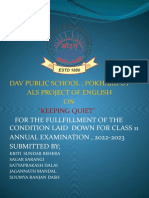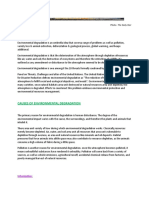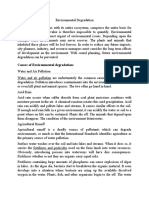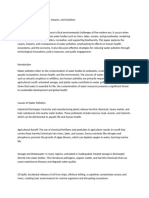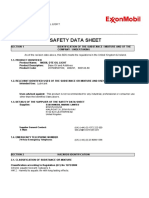0 ratings0% found this document useful (0 votes)
2 viewsTopic 5
Topic 5
Uploaded by
palsesismynamesCopyright:
© All Rights Reserved
Available Formats
Download as TXT, PDF, TXT or read online from Scribd
Topic 5
Topic 5
Uploaded by
palsesismynames0 ratings0% found this document useful (0 votes)
2 views62 pagesOriginal Title
TOPIC 5
Copyright
© © All Rights Reserved
Available Formats
TXT, PDF, TXT or read online from Scribd
Share this document
Did you find this document useful?
Is this content inappropriate?
Copyright:
© All Rights Reserved
Available Formats
Download as TXT, PDF, TXT or read online from Scribd
Download as txt, pdf, or txt
0 ratings0% found this document useful (0 votes)
2 views62 pagesTopic 5
Topic 5
Uploaded by
palsesismynamesCopyright:
© All Rights Reserved
Available Formats
Download as TXT, PDF, TXT or read online from Scribd
Download as txt, pdf, or txt
You are on page 1of 62
TOPIC 5
Human Activities Affecting Soil and Water
OBJECTIVES
At the end of this module, you will be achieving the following objectives:
explain how different activities affect the quality and availability of water for
human use; (S11ES-Ig-16)
identify human activities, such as farming, construction of structures, and waste
disposal, that affect the quality
and quantity of soil; (S11ES-Ig-17)
identify common materials or substances associated with each type of waste. For
example, plastics for solid
waste, wastewater for liquid waste, and emissions for gaseous waste;
define and differentiate between various waste types, including solid waste,
liquid waste, and gaseous waste,
understanding their distinct characteristics and properties;
take personal responsibility for reducing waste in their daily lives, reflecting
a sense of duty towards preserving
the environment, and
encourage students to consider their responsibility as stewards of the
environment and the importance of
protecting natural resources for future generations.
Lasallian Core Value/s in Focus
May transform their learning into practical use for the betterment of society and
educate the uneducated.
Possess the skills and competencies needed to contribute to the common good.
Discern with others the immediate and underlying causes as well as short- and
long-term effects of socioenvironmental problems.
WEEK 6-7 : HUMAN ACTIVITIES AFFECTING SOIL AND WATER
ENGANGE: The 7 Environmental Principles (10pts.)
ELABORATE: LEARN 2.1: Impacts of Waste on Health and Environment
(5pts.)
EVALUATE: Test Yourself (30pts.)
What is
POLLUTION?
Pollution is the introduction of harmful materials into the
environment. These harmful materials are called pollutants.
Pollutants can be natural, such as volcanic ash. They can also
be created by human activity, such as trash or runoff produced
by factories. Pollutants damage the quality of air, water, and
land.
What is SOIL?
It is a loose surface material
that covers most land. It
consists of inorganic particles
and organic matter. Soil
provides the structural support
to plants used in agriculture
and is also their source of
water and nutrients.
(Agriculture Victoria, 2021)
Why SOIL matters?
Soil provides a host of crucial services for both people
and the planet.
Soil puts food on our plates, purifies our water, protects us
against flooding and combats drought.
It's also key to tackling climate change as it captures and
stores vast amounts of carbon.
There is no food security without healthy soils.
What is SOIL POLLUTION?
Land that is arid and can no
longer be cultivated can be one
of the characteristics of
polluted land. Here are some
causes of soil pollution:
a. Acid compounds
b. Excess pesticides
c. Chemical fertilizers
d. Industrial, factory and also
nuclear waste
e. Household waste such as
detergent.
HUMAN ACTIVITIES AFFECTING THE QUALITY
AND QUANTITY OF SOIL
Since soil is so vital to human
life, humans have to move and
manipulate it in order to utilize it.
This, however, can lead to
environmental problems, soil
loss, and degradation. Soil
degradation is a humaninduced or natural process
which impairs the capacity of
soil to function.
EROSION
Erosion - occurs when soil particles are
detached, transported, and deposited.
Erosion is a natural geologic process,
however, humans can accelerate the
process by removing cover. Accelerated
erosion occurs at 10-1000 times the
natural rate. Erosion can happen in all of
the biomes on earth, and can be caused
by removing trees or grasses. Removing
the soils generally leads to other types of
degradation and reduced food production.
Soil can be eroded by wind or water.
DESERTIFICATION
Desertification - is the extreme
degradation of productive land in arid and
semi-arid areas. This is most common in
the tropical savannah and prairies. This
can create poor quality vegetation, and the
spreading of deserts to areas that weren't
deserts before. (Increasing droughts can
eventually turn an area into a desert.)
DEFORESTATION
Deforestation - is a very severe problem. Deforestation or forest clearance is
the
removal of a forest or stand of trees from land that is then converted to non-
forest use.
Deforestation can involve conversion of forest land to farms, ranches, or urban
use.
MINING
Mining - Surface mining can drastically
change the landscape. When the
materials are gone, soil science becomes
very important to the reclamation process,
which aims to restore the landscape and
plants to pre-mining conditions.
URBANIZATION
Urbanization - refers to the population
shift from rural to urban areas, the
corresponding decrease in the
proportion of people living in rural
areas, and the ways in which societies
adapt to this change.
WASTE DISPOSAL
Waste disposal - since the waste
was disposed directly onto surface of
soil, a number of contaminants
including heavy metals readily
penetrate and eventually they
contaminate the soil and affect
vegetation abundance of the area.
What is WATER?
It's found everywhere on Earth, from the polar ice
caps to steamy geysers, and wherever water flows
on this planet, you can be sure to find life.
Why WATER is
important?
Water is vital for life. Clean fresh water is
necessary for drinking and sanitation, providing
for our crops, livestock and industry, and creating
and sustaining the ecosystems on which all life
depends.
What is WATER POLLUTION?
Water pollution occurs when
harmful substances—often
chemicals or microorganisms—
contaminate a stream, river, lake,
ocean, aquifer, or other body of
water, degrading water quality and
rendering it toxic to humans or the
environment.
Human Activities Affecting Quality and Availability of
Water for Human Use
AGRICULTURE
Agriculture - is a huge contributor to
water pollution, from fertilizers used for
row crops to the manure created by
large-scale animal agriculture.
FOSSIL FUEL PRODUCTION
Fossil fuel production - Sulfue dioxide (SO2),
Nitrogen oxides (NOx), and Carbon dioxide
(CO2) react with water vapor, oxygen, and
other chemicals to form acid rain. Acid rain can
contaminate fresh water sources, resulting in
harmful algal blooms that reduce water oxygen
levels and harmful fish populations and other
wildfire.
CLIMATE CHANGE
Climate change refers to long-term shifts in
temperatures and weather patterns. These
shifts may be natural, but since the 1800s,
human activities have been the main driver of
climate change, primarily due to the burning of
fossil fuels (like coal, oil and gas), which
produces heat-trapping gases.
cons (disadvantages):
Climate change has been linked to an
increased risk of the formation of harmful algal
blooms in water. These toxic blooms are
causing environmental degradation in our lakes,
rivers, streams, and coasts. These toxic blooms
develop when nitrogen and other nutrients are
washed off land surfaces into waterways from
storms.
Droughts are slow-onset disasters caused by
climate change and water shortage.
SEWAGE
In some places, population growth has
strained wastewater treatment plants to
the point where they cannot handle the
amount of sewage that is produced by
the city or town.
QUESTION?
CLARIFICATIONS?
What are the techniques that can both protect and conserve our soil and
water resources?
Types of
POLLUTION
QUESTIONS TO POUNDER
How can solid, liquid, and gas wastes impact the
health of living organisms?
How can solid, liquid, and gas wastes impact the
environment?
SOLID WASTE
Impact on Human Health
Improper disposal of solid waste can
lead to the proliferation of disease
vectors like rats and mosquitoes,
contributing to the spread of diseases
such as dengue fever and cholera.
The burning of solid waste can release
harmful air pollutants linked to
respiratory diseases.
Impact on Environment
Landfills leach hazardous chemicals
into the soil and groundwater,
contaminating ecosystems.
The production and disposal of nonbiodegradable plastics contribute to
environmental degradation plastics
pollution coalition.
LIQUID WASTE
Impact on Human Health
Discharging untreated liquid waste
water into water bodies can contamintae
drinking water sources, leading to
waterborne diseases such as diarrhea
and cholera.
Exposue to toxic chemicals in liquid
waste can cause long-term health
problems.
Impact on Environment
Liquid waste can disrupt aquatic
ecosystems by depleting oxygen
levels and affecting aquatic life.
It can also result in eutrophication,
where excessive nutrient levels lead
to harmful algal blooms.
GASEOUS WASTE
Impact on Human Health
Gaseous waste emission, such as air
pollutants from industrial processses
and vehicles can worsen respiratory
conditions, including asthma and
bronchitis.
Long term exposure to air pollution is
linked to cardiovascular diseases.
Impact on Environment
Gaseous waste, particularly
greenhouse gases like carbon
dioxide (CO2) contribute to climate
change leading to rising global
temperatures and associated
environmental disruptions.
IT’S TIME TO
SHARE!
As a Lasallian Student...
Reflect on the concept of leaving a
positive legacy for the planet. How
important is it for you to contribute to a
healthier environment for future
generations?
QUESTION?
CLARIFICATIONS?
You might also like
- Cardiac Pacing and ICD ReviewDocument21 pagesCardiac Pacing and ICD ReviewAlexander Edo Tondas100% (1)
- Lyoprint AP Antifoam and De-Aerating Agent: Technical Data SheetDocument4 pagesLyoprint AP Antifoam and De-Aerating Agent: Technical Data SheetLambo Sun67% (3)
- SURVEY Questionnaire For Hospital Waste Management QuestionnaireDocument7 pagesSURVEY Questionnaire For Hospital Waste Management QuestionnaireRaj kumar67% (3)
- Accuracy and Distortion of Composite Parts and ToolsDocument20 pagesAccuracy and Distortion of Composite Parts and ToolsMike DunhamNo ratings yet
- Environmental Pollution and Its SollutionsDocument23 pagesEnvironmental Pollution and Its SollutionsHamza IslamNo ratings yet
- Dav Project EngDocument24 pagesDav Project EngMonster GamerNo ratings yet
- Folio Bio Form 4 Yay!!!!!!!!!!!!Document15 pagesFolio Bio Form 4 Yay!!!!!!!!!!!!Balqis RuslanNo ratings yet
- Green Modern Environment and Ecology PresentationDocument15 pagesGreen Modern Environment and Ecology PresentationAmy Guanco PonceNo ratings yet
- Environmental IssuesDocument23 pagesEnvironmental IssuesAneen ZamanNo ratings yet
- Assingment EGfnl XMLDocument7 pagesAssingment EGfnl XMLSaeid Hasan EmonNo ratings yet
- ENVIRONMENT STUDIES - Shiouly Mukherjee1Document17 pagesENVIRONMENT STUDIES - Shiouly Mukherjee1shiouly MukherjeeNo ratings yet
- Pollution and Enviromental DegradationDocument19 pagesPollution and Enviromental DegradationMORTAL SNo ratings yet
- CONTEMPORARYDocument53 pagesCONTEMPORARYRhodjane Dela CruzNo ratings yet
- Unit 2 ADocument8 pagesUnit 2 Adakshata0409No ratings yet
- PP 3Document12 pagesPP 3Peter ParkarNo ratings yet
- Environmental EducationDocument11 pagesEnvironmental EducationRai DiocadesNo ratings yet
- Earth Science (Water and Soil)Document5 pagesEarth Science (Water and Soil)furmary06No ratings yet
- Environmental Awareness & Energy Crisis PDFDocument5 pagesEnvironmental Awareness & Energy Crisis PDFNhel AlvaroNo ratings yet
- Environmental Resource ManagementDocument20 pagesEnvironmental Resource ManagementAnkita Roy ChowdhuryNo ratings yet
- NSTP Report FinalDocument23 pagesNSTP Report FinalDwight AlipioNo ratings yet
- Assingment EG XMLDocument6 pagesAssingment EG XMLSaeid Hasan EmonNo ratings yet
- Jurnal 2. AppraisalDocument4 pagesJurnal 2. Appraisaletik ainun rohmahNo ratings yet
- Causes and Impact of Environmental Degradation: Name: Dhruvika Kokate Roll No: 286 STD: Fybcom Div: 2Document8 pagesCauses and Impact of Environmental Degradation: Name: Dhruvika Kokate Roll No: 286 STD: Fybcom Div: 2Dhruvika KokateNo ratings yet
- Environmental Pollution EssayDocument9 pagesEnvironmental Pollution EssayAbid AliNo ratings yet
- Environment Pollution Caused Due To Dumping of Waste DisposalDocument11 pagesEnvironment Pollution Caused Due To Dumping of Waste Disposalshijith22No ratings yet
- PolllutionDocument13 pagesPolllutionHapi PrinceNo ratings yet
- Ecological BalanceDocument74 pagesEcological Balanceczarinabanana77No ratings yet
- Ilns 3 2014 1 6Document6 pagesIlns 3 2014 1 6akrmbaNo ratings yet
- The Impact of Environmental Pollution On HumanDocument6 pagesThe Impact of Environmental Pollution On HumanErdi 'Day' SidhartaNo ratings yet
- Env Edu Task 1Document28 pagesEnv Edu Task 1sweetshilpa2207No ratings yet
- Impacts of Land Use Change On The EnvironmentDocument8 pagesImpacts of Land Use Change On The EnvironmentMariel Adie TanNo ratings yet
- PollutionDocument1 pagePollutionSantha SanthaNo ratings yet
- P5Document2 pagesP5AJ GAMERS WITH POTATO PCNo ratings yet
- Elaborate Consequence or Negative Effects of Environmental DegradationDocument8 pagesElaborate Consequence or Negative Effects of Environmental DegradationAbdela Aman MtechNo ratings yet
- Présentation 1Document8 pagesPrésentation 1mitsotsoregisNo ratings yet
- Water Pollution: Sources, Effects, Control and Management: Mediterranean Journal of Social SciencesDocument4 pagesWater Pollution: Sources, Effects, Control and Management: Mediterranean Journal of Social Sciencesfegita manopoNo ratings yet
- Local Environment PariDocument13 pagesLocal Environment PariArpit RaikwarNo ratings yet
- đề cương TA2Document11 pagesđề cương TA2hangocle102No ratings yet
- Envinronmental PollutionDocument28 pagesEnvinronmental PollutionThe FlashNo ratings yet
- Causes of Environmental DegradationDocument9 pagesCauses of Environmental DegradationAkanksha MhatreNo ratings yet
- 12 AND AND: Unit Ecology Environment: Issues ChallengesDocument12 pages12 AND AND: Unit Ecology Environment: Issues ChallengesNavratan KediaNo ratings yet
- Earth Sci m8 3Document16 pagesEarth Sci m8 3Sangel KsjskNo ratings yet
- Role of Individuals in Environmental ConservationDocument11 pagesRole of Individuals in Environmental ConservationApoorv GoelNo ratings yet
- MST 100 PERFORMANCE (Word)Document16 pagesMST 100 PERFORMANCE (Word)Baby Honey IbayNo ratings yet
- Human-Impacts-on-the-Earths-Systems-1Document20 pagesHuman-Impacts-on-the-Earths-Systems-1Ritzy DelopinesNo ratings yet
- WATER AN ENVIRONMATAL ISSUE - SuyashDocument10 pagesWATER AN ENVIRONMATAL ISSUE - SuyashSuyashNo ratings yet
- Bio Folio Form 4Document10 pagesBio Folio Form 4Ahmad FaizNo ratings yet
- Environmental Pollution StudiesDocument27 pagesEnvironmental Pollution Studiestum chrisNo ratings yet
- Final ProjectDocument5 pagesFinal ProjectYatziri LopezNo ratings yet
- Environmental Assinment 1Document12 pagesEnvironmental Assinment 1Wellings ChizumilaNo ratings yet
- STS MaterialsDocument11 pagesSTS MaterialsJonalyn PiamonteNo ratings yet
- Week009 Global and Environmental Problems and Global EffortsDocument4 pagesWeek009 Global and Environmental Problems and Global EffortsEthan RosarioNo ratings yet
- Research On Land PollutionDocument2 pagesResearch On Land PollutionRicha GuptaNo ratings yet
- Pollution and OverpopulationDocument37 pagesPollution and OverpopulationMa Lilia Geraldez EndencioNo ratings yet
- GoegraphyDocument9 pagesGoegraphyNDATIMANA JOHNSONNo ratings yet
- Clase 8 AbrilDocument10 pagesClase 8 AbrilAda Luz Daza HernándezNo ratings yet
- Air Pollution: Air Is Mainly A Mixture of Various Gases Such As Oxygen, Carbon DioxideDocument14 pagesAir Pollution: Air Is Mainly A Mixture of Various Gases Such As Oxygen, Carbon Dioxidenidhichoudhary1305No ratings yet
- Esco TarogDocument16 pagesEsco TarogMuhammad AbdulNo ratings yet
- Water PollutionDocument4 pagesWater PollutionbcakalondaNo ratings yet
- Resources and PollutionDocument23 pagesResources and PollutionSharmaine marmolNo ratings yet
- Environmental DegradationDocument11 pagesEnvironmental DegradationUmar IsaNo ratings yet
- Shyneth Valendo Activity 1Document3 pagesShyneth Valendo Activity 1Valendo ShynethNo ratings yet
- 16.1, 16.3 and 16.4 PDFDocument28 pages16.1, 16.3 and 16.4 PDF....No ratings yet
- LAS in SCience 5 Q1W1 2 MELLA EditedDocument7 pagesLAS in SCience 5 Q1W1 2 MELLA EditedChassy ChassyNo ratings yet
- Msds HCLDocument6 pagesMsds HCLGia ObligadoNo ratings yet
- Binary CPD WKSTDocument3 pagesBinary CPD WKSTapi-2982478730% (1)
- Proceeding BookDocument665 pagesProceeding BookLies WuryanitaNo ratings yet
- MFI Homo PPDocument2 pagesMFI Homo PPalexandria.padilla11No ratings yet
- Jurnal TekZImDocument10 pagesJurnal TekZImFestus Septian Z. YoesafatNo ratings yet
- d3) Epilux4 2763Document2 pagesd3) Epilux4 2763Salman KhanNo ratings yet
- Name - Vaibhav Tiwari Class & Section - Xi-A Roll No-40 Chemistry Project FileDocument21 pagesName - Vaibhav Tiwari Class & Section - Xi-A Roll No-40 Chemistry Project FilebaijiNo ratings yet
- Rekap PBF 2020Document238 pagesRekap PBF 2020'ahelha QurniatiiNo ratings yet
- Nomenclature of Organic Compounds - pdf-67Document8 pagesNomenclature of Organic Compounds - pdf-67Abhinandan MISHRANo ratings yet
- Homeostasis Practice QuizDocument2 pagesHomeostasis Practice QuizRofekiNo ratings yet
- Buttermilk and Ghee Residue - PDFDocument13 pagesButtermilk and Ghee Residue - PDFSun INsurance AgencyNo ratings yet
- Mic.021 Gram StainDocument6 pagesMic.021 Gram StainakelloNo ratings yet
- Mobil Dte Oil Light MsdsDocument13 pagesMobil Dte Oil Light MsdsNaseemNo ratings yet
- ENGG 413 - Environmental Science and EngineeringDocument283 pagesENGG 413 - Environmental Science and Engineeringulol ululNo ratings yet
- Enig En300 NickelDocument6 pagesEnig En300 Nickelrotaru_ionNo ratings yet
- Periodic Properties-3Document17 pagesPeriodic Properties-3qweerrNo ratings yet
- Experiment 1: Safety Measures During Use and Preparation of Chemical SubstancesDocument6 pagesExperiment 1: Safety Measures During Use and Preparation of Chemical SubstancesAliah AzizNo ratings yet
- CalamansiDocument4 pagesCalamansiAmber ThompsonNo ratings yet
- Y StrainerDocument2 pagesY StrainerAishiteruNo ratings yet
- SERIES 7000 Paste Slakers: Fully Automated Lime Slaking SystemsDocument4 pagesSERIES 7000 Paste Slakers: Fully Automated Lime Slaking Systemssoumyarm942No ratings yet
- GS40 ManualDocument25 pagesGS40 ManualOri CaspiNo ratings yet
- 4 EmulsionsDocument17 pages4 EmulsionsAmit AgarwalNo ratings yet
- Review 2016Document21 pagesReview 2016WanMohd AzwadyNo ratings yet
- KSB AmriDocument40 pagesKSB Amriseeralan_1986No ratings yet
- Brauer - Ocr 1523 1536Document14 pagesBrauer - Ocr 1523 1536ErickNo ratings yet





